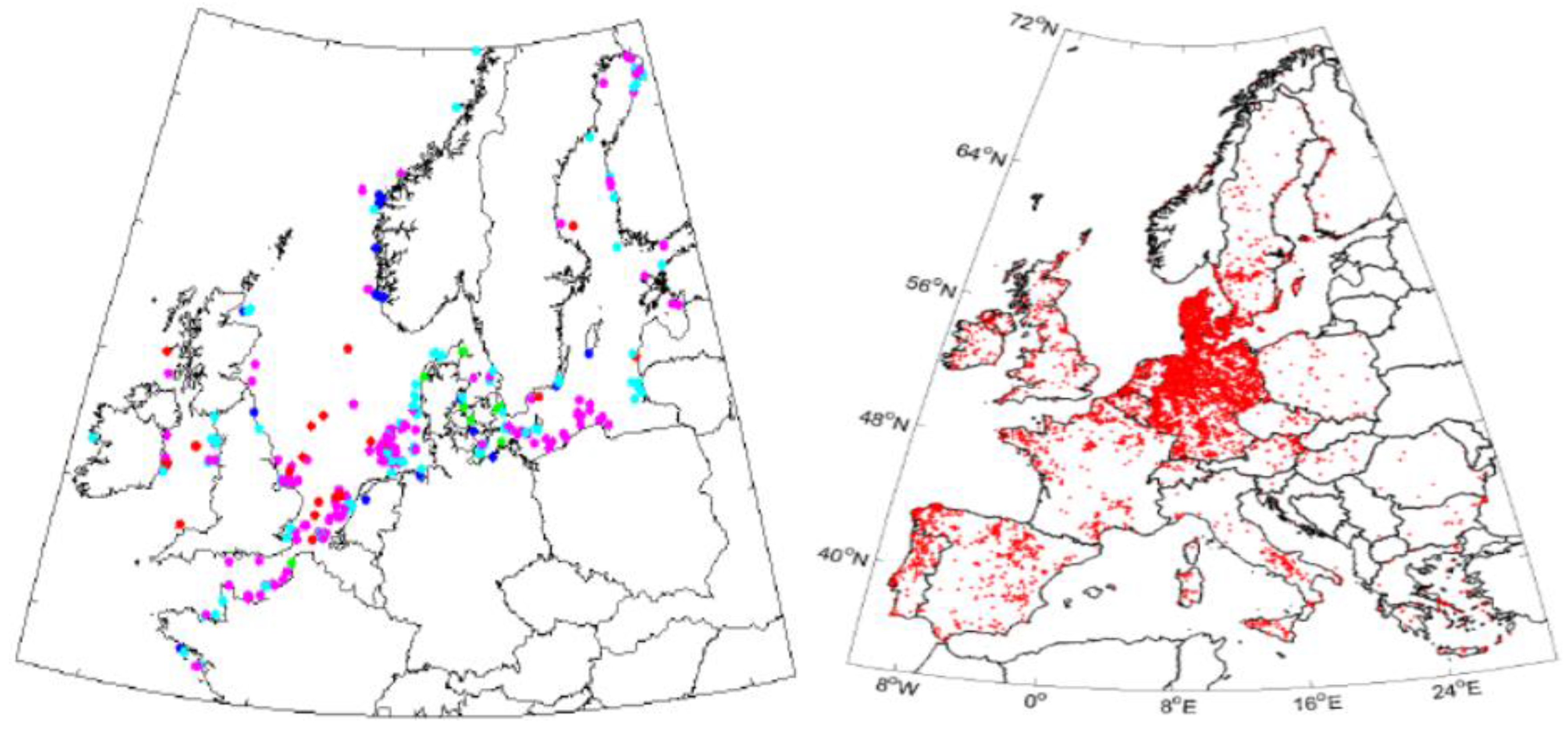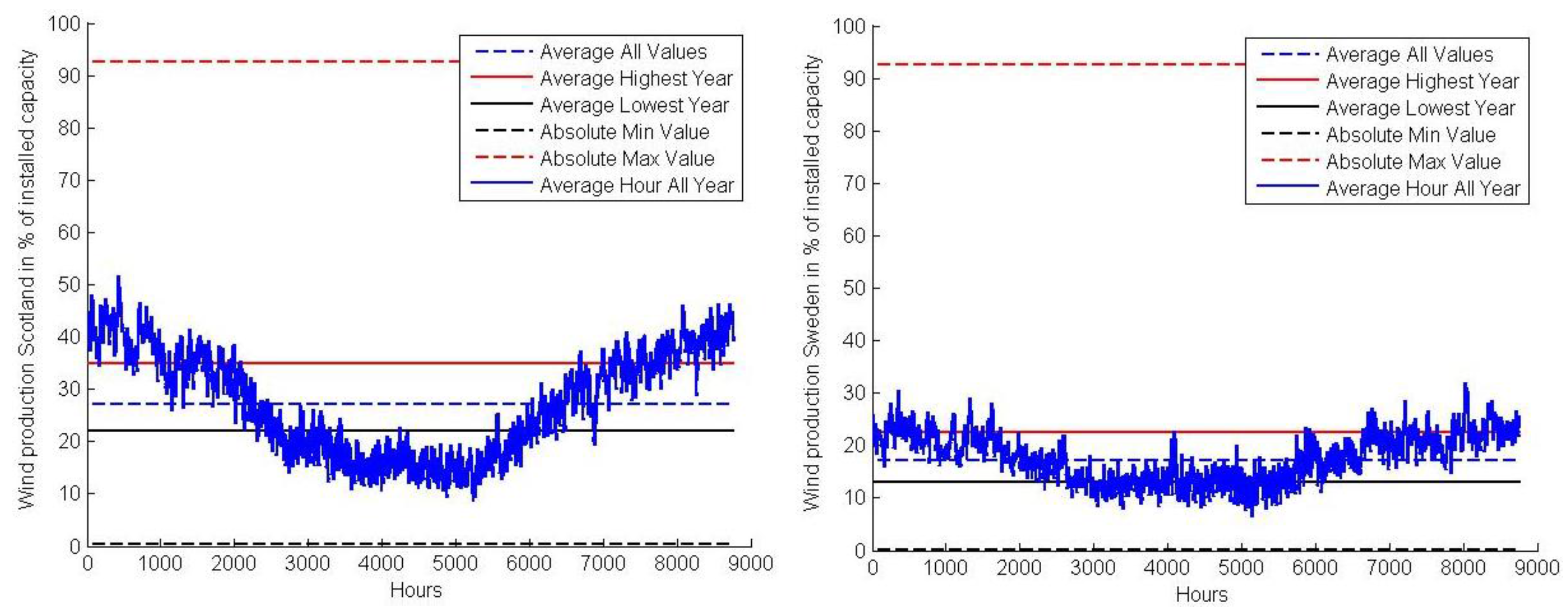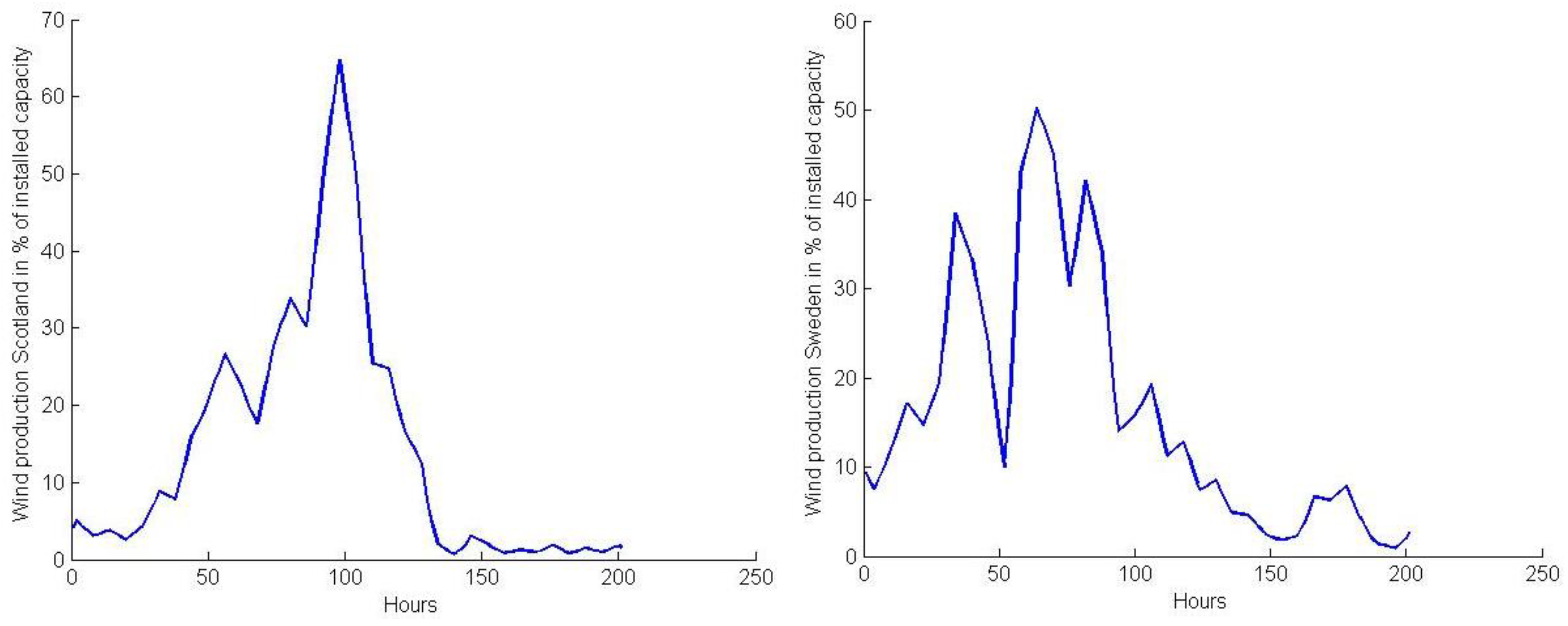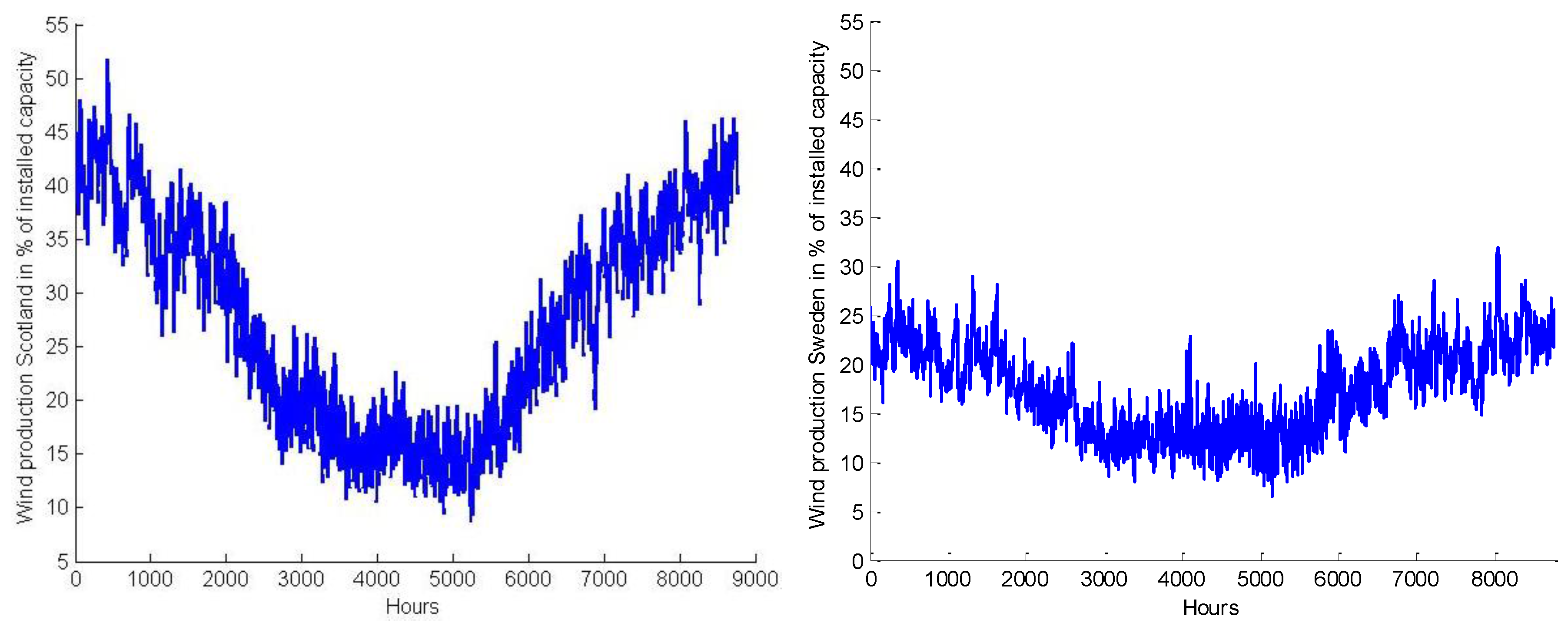2. Variability Characteristics
In this section, different variability characteristics are identified based on the articles reviewed. A large number of scientific articles have been published addressing the variability of renewable resources. However, we found a limited literature that presents a structured overview of various variability characteristics and their respective research fronts. We chose to structure the review according to the following variability characteristics: Distribution Long Term, Distribution Short Term, Step Changes, Autocorrelation, Spatial-correlation, Cross-correlation and Predictable Pattern.
Some variability characteristics are identified based on a paper analyzing solar, wind and tidal resources by focusing on a small geographical region in the UK [
8]. Distribution is one of several variability characteristics. It can be defined as discrete power outputs recorded during stipulated time periods, and assessed over a longer period of time. For the purposes of this review, we have chosen to split “Distribution” into two categories; Short-Term (minutes, less than one hour) and Long-Term (one hour or more). There are several reasons for this subdivision:
Several power markets operate with an hourly resolution (Day-ahead Market).
Often, a variety of technologies will be used for balancing short-term (e.g., batteries) and longer-term variations (e.g., thermal plants with start-up costs).
Databases (at least in the case of wind resources) often have a resolution of one or several hours (e.g., see examples in [
17]).
Several of the papers reviewed refer to ‘Step Changes’ as a variability characteristic. Step changes are changes in resource availability that occur over short time steps ranging from minutes to a few hours, and is the third characteristic that we review in this study. Another variable characteristic is Autocorrelation [
8]. Autocorrelation can be defined as the “existence of statistical dependence among successive values of the same variable”, and this is the fourth characteristic we discuss. The correlation of wind speed records between spatially distributed sites, and the corresponding correlation of solar radiation records for distributed sites have been, and still are, the focus of many research projects. For this reason, we identify Spatial Correlation as one of the variability characteristics. Wind and solar resources may exhibit different diurnal and seasonal patterns. However, they also complement each other to some degree. In studies of future power systems in which renewables make major contributions, it is useful to study the characteristic called Cross Correlation. Wind, solar and tidal resources also exhibit predictable patterns [
8]. We have chosen to identify the annual and diurnal Predictable Patterns of renewables as a distinctive variability characteristic. Pattern prediction for wind and solar resources is a complex process, and forecasting is a topic addressed in many scientific papers. Unpredictability could also have been considered as a variability characteristic, but is not included in this review in order to limit scope of the study.
A recent study about variability of wind and solar power production in the present European power system includes the several of the same characteristics as discussed in this paper [
18]. The paper do not used the same names of the characteristics as in this paper, but the content is mainly the same. The paper has some additional characteristics related to the demand, e.g., surplus in net load. Surplus in net load is an important aspect of a system with high shares of variable renewable production. It should be added in further extensions of this work with future load profiles included.
There are studies which categorize variability properties of RES related to the power system costs the property causes, e.g., [
14]. In this study variable production is split in uncertain, location-specific and temporal variability. Uncertain includes the limited predictability of inherent natural variations of wind speed or solar irradiation. This property is the same as our Unpredictability characteristic. Location-specific is costs which occur because the primary energy carrier of wind and power cannot be transported like fossil or nuclear fuels. The location specific property is related to our Spatial Correlation characteristic. However, the perspectives are very different: e.g., [
14] discusses the location specific costs while our study discusses how spatial (non) correlation can be used to smooth out variability (in the Conclusion section). Finally, according to [
14] temporal variability has two impacts. The first one is increased ramping and cycling, and the second one is temporal matching of variable RES supply profiles with demand. Ramping and cycling is correspondent to our characteristic Step Changes. Again, the perspectives of our study and [
14] is very different: [
14] seems to have focus more on the present system than our study and assumes that demand is fairly price-inelastic while our study focuses on establish knowledge to be able to assess which parts of the variability can be balanced by demand flexibility.
Each of the characteristics is discussed in detail in the following sections. For each of the seven characteristics we provide a general description and a description of the knowledge front for onshore and offshore wind and solar power production for Europe.
4. The Variability Characteristics and Their Relationship to the Power System
The variability characteristics have different impacts/relationships to the power system. Distribution long and short term include in our definition among other minimum and maximum values for production from aggregated wind and solar resources. The minimum value indicates the base load production that can be expected from the wind and solar resources. Looking at the net load (the difference between the load and the production from variable resources), the net load has to be supplied in all time intervals. In the present power system dis-patchable generators will balance the net load. Thus, the minimum net load value indicates the fraction of the generators capacity that must be capable of shutting off or operating at significant part load [
79].
The difference between maximum and the minimum net load value indicates the minimum generator fleet power capacity that is required to meet the load demand of the system. Reserve requirements will be in addition to this value. In a future power system, energy storage and demand flexibility may balance parts of the difference between the maximum and the minimum net load value. The distribution characteristic also includes the average of the wind and solar power production. The average value gives indications for the present system how much of the total installed dis-patchable generators that are typically used over a given time period. Dis-patchable generators will in the present system over a time period balance the difference between the maximum net load and the average net load. Thus, this difference gives indications about the revenue possibility for the owners of conventional generators.
The step change characteristic gives in the present system information about how fast the conventional production have to either increase or decrease production. If storage and demand response shall balance the step changes, it gives information about expected response time and capacity of those measures. Furthermore, the frequency of the step changes gives information about how often the storage has to charge or dis-charge or how often demand has to respond to sudden increases or decreases in output from wind and solar power production plants.
The auto-correlation characteristic provides knowledge about long lasting periods with consecutive low or high net load. In the present system, the periods with low production can be balanced by dis-patchable production. In a future system with limited dis-patchable capacity left in the system, such periods may be particularly challenging. Storage technologies except for hydro-reservoirs, hydrogen and compressed air will discharge in a few hours. Furthermore, demand response will likely reduce after a few hours. Long lasting periods with surplus in the net load will result in reduced income for the owners of dis-patchable power plants as the plants have to run on part-load or shut down. Furthermore, parts of the renewable production may be curtailed, and that will lead to reduced income for the owners of the renewable production.
The characteristic predictable patterns of wind and solar resources impacts how new measures for balancing the variability match with the needs for balancing. E.g., if hydropower in Scandinavia is going to be used for balancing some of the future variability in the production in Germany, the relationship between the Predictable patterns and the yearly pattern for reservoir filling and depleting should be studied. E.g., in summer time the reservoirs are often filled up and it is not possible to pump more waters to the reservoirs even if there is surplus in the production from PV plants in Continental Europe.
The characteristics spatial correlation and cross-correlation can be utilised to smooth out production and reduce variability by connection different regions with grids.
5. Discussion and Conclusions—The Research Gap
The aim of this paper is to establish a state-of-the-art overview of the knowledge about the variability characteristics of renewable resources for the European region in a long term perspective. The review is motivated by EUs long term targets for renewable power production and also for their ambition to use demand flexibility and increased interconnectors to reduce variability challenges. By review of available scientific literature, we aim to identify the knowledge front for variability of future wind and solar power production along two dimensions:
How location, mix and optimal shares of wind and solar power production can contribute to smooth out the variability (correlation of resources).
How the aggregated wind and solar power production will vary in different time perspectives in order to be able to study how the variability can be cost-efficiently balanced by measures (demand response, different type of storage, grids) with different properties.
We structured the review in seven variable characteristics: distribution long-term (durations greater than one hour), distribution short-term (durations less than one hour), step changes, autocorrelation, spatial correlation, cross correlation and predictable patterns. This categorisation could have been organised in several ways, and there is no single correct answer to the problem. The approach proposed here represents a means of systematically subdividing a multi-faceted variability concept. Each of the characteristics is described in general terms, accompanied by a discussion of recent and relevant research related to wind power (onshore and offshore), solar power, and combined wind/solar power systems. The article focuses mainly on results from Europe, but a large number of the findings have global relevance.
The first dimension is mainly related to the characteristics spatial correlation, cross correlation and predictable patterns. We found results confirming that the output from an integrated European power production based on solar and wind resources can be smoothed dependent on the mix and location of wind and solar resources. e.g., there is compensating trends in wind energy North and South of 45°N, so by increasing grid capacities between North and South Europe, it is probably possible to reduce variability. Source [
71] showed that there is negative correlation between wind resources in e.g., Germany and Spain. The results are in accordance with source [
69] which concludes that major benefits could be achieved from a more internationally renewable deployment policy providing incentives for the location of new wind farms that maximises the efficiency of overall European wind portfolios. These two studies focus only on wind power production focus. The source [
33] showed that for an example of a 100% wind and solar based power production in Europe, the optimal mix of wind and solar in a seasonal perspective was 55% wind and 45% solar. However, the results in this paper are based on one specific scenario of the future portfolio and the results cannot be assumed to have general validity. All in all, we find that optimal mix and location wind and solar resources are limited studied for Europe. There are indications about possibilities for considerable reductions in variability, and we recommend that this is further investigated. It should in particular be related to EUs ambitions for increases in cross-border connection to 15% of installed electricity production capacity.
Turning to the second dimension, it can be assessed based on the four characteristics: distribution long-term, distribution short-term, step changes and autocorrelation. We found very limited results for these characteristics both on a national level and on an integrated European level for the future power system. In general, issues related to the variability of power production from onshore wind or solar resources are the subject of far more scientific papers than those related to offshore wind resources or wind and solar in combination. Furthermore, studies addressing variability in relation to a single or just a few wind or solar farms are much more common than those addressing large geographical regions, such as Europe as a whole.
EU aim to use demand response to balance some of the variability from future wind and solar power production. But since short term variations of combined wind and PV production are limited studied, it is difficult with present available knowledge to assess how the power system will be impacted if the demand side contribute with different volumes and durations of flexibility.
As mentioned in
Section 1.2, for assessment of the value of the increased connection between the hydropower dominated Scandinavian system and the Germany and other neighbouring countries it is of particular interest to know how often and how long there are periods with very low production from the wind and PV based production (auto-correlation and cross-correlation). There are some results available for single countries or regions. Source [
22] showed that the wind power production can be less than 5% for up to 48 h at an integrated European level. The study does not include PV production, and further studies are necessary.
In
Table 12 we have indicated the impacts of the variability characteristics on the future power system and questions for further research. The list of questions does not aim to be exhaustive. The four first characteristics in the list will need to be balanced by demand response, storage, more grids or dis-patchable production and we indicate in the Table which efforts are most relevant. The research questions listed in
Table 12 must be studied based on simulations of the future European power system and with different location and sizes of wind and solar power production. The simulations must include different scenarios for future load profiles. Furthermore, the simulations must include studies of possible locations of increased interconnectors between European countries given EU’s ideas of increasing cross-border connections to 15% on a case-by-case basis.
We recommend the establishment of a scheme that permits a more systematic assessment of production variability. This will promote a greater understanding of the issues at hand, and will permit a comparison of the different power production portfolios combined with different increases of interconnectors. The characteristics as proposed in this paper could constitute a starting point for such a scheme, although further work should be carried out to enable the inclusion of issues such as measures and metrics for consistent comparison.
Even though the EU is aiming to develop a future power system with very high contributions from wind and solar production, we have found only a few studies that have analysed the variability characteristics of such a system:
One study [
32] addresses 1-h ramps in the future European power system for different contributions of wind and solar production. The study is described in
Section 3.1.6.
One paper investigates the least-cost options for integration of intermittent renewables in low-carbon power system [
11]. The investigations is based on many assumptions related to production mixes and renewable power production location, demand, demand flexibility, transmission capacities, storage, costs for technologies, fuels, CO
2 etc. Western Europe is aggregated to 6 regions and one year of meteorological data is used in the simulations.
Two studies, [
33,
34], based on the same datasets, address the optimal mix of wind
versus solar contributions as part of a European power system based entirely on renewable resources. The first of these studies introduces a seasonal perspective, while the other addresses energy storage capacity needs and annual balancing energy requirements and examines how hourly balancing power varies with generation capacity surpluses. These studies are also described in
Section 3.1.7.
In general these studies are “snapshoots” of the future. In addition, several studies have been carried out based on the same weather conditions and system model as is applied in source [
33]. These include sources [
36,
37,
38,
39,
40]. These studies analyse solutions to issues caused by variability in the future European power system, but none of them include demand response. To our understanding all these studies uses the same scenario for renewable production. Thus, it is likely that the results are not valid for other development of location and mixes of wind and solar power production.
As said in the introduction to this review: “Deriving an efficient mix of integration options requires carefully analysis of power system considering the complex integration of variable renewables, other generation technologies and integration options” [
12]. The variability is complex in itself and has many characteristics as shown in this study. Our final recommendation is to establish a basic understanding about this variability before it is assessed how it most cost-efficient can be balanced. By combining too many assumptions and simplifications into the same analyses, it is a possibility that opportunities are lost, e.g., hardly any study focuses on how to utilise the wind and solar resources themselves to smooth out production in a European perspective. Furthermore, by understanding the variability it is possible as proposed in the first section of this review to study how demand flexibility can balance variability in different time perspectives, instead of just assuming a certain share. This recommendation is in accordance with the recommendations in the IEA ECES26 report [
16] described in
Section 1.2.













